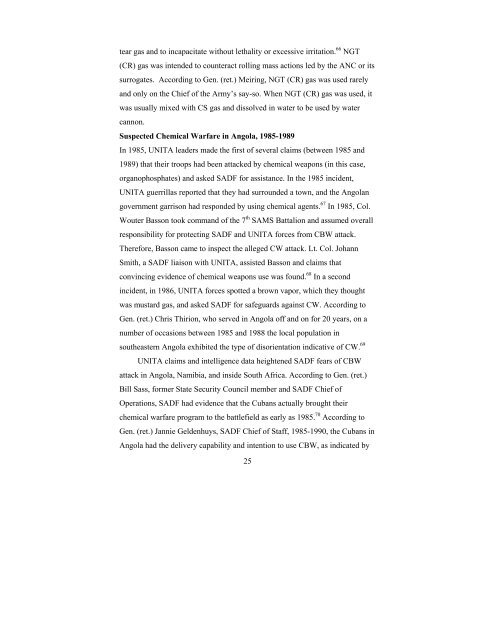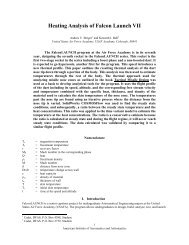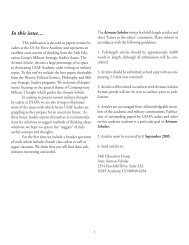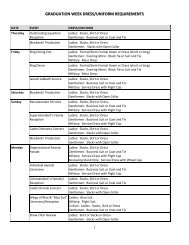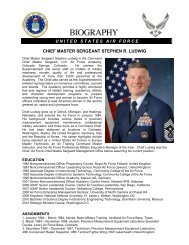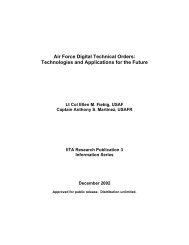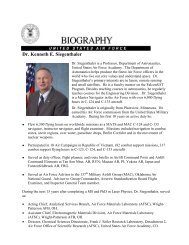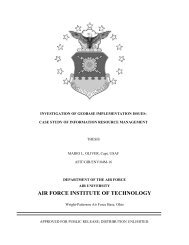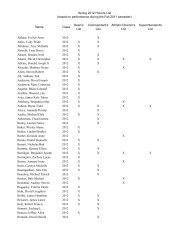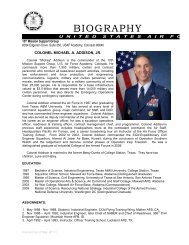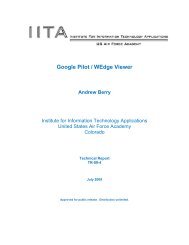the rollback of south africa's biological warfare program
the rollback of south africa's biological warfare program
the rollback of south africa's biological warfare program
You also want an ePaper? Increase the reach of your titles
YUMPU automatically turns print PDFs into web optimized ePapers that Google loves.
tear gas and to incapacitate without lethality or excessive irritation. 66 NGT<br />
(CR) gas was intended to counteract rolling mass actions led by <strong>the</strong> ANC or its<br />
surrogates. According to Gen. (ret.) Meiring, NGT (CR) gas was used rarely<br />
and only on <strong>the</strong> Chief <strong>of</strong> <strong>the</strong> Army’s say-so. When NGT (CR) gas was used, it<br />
was usually mixed with CS gas and dissolved in water to be used by water<br />
cannon.<br />
Suspected Chemical Warfare in Angola, 1985-1989<br />
In 1985, UNITA leaders made <strong>the</strong> first <strong>of</strong> several claims (between 1985 and<br />
1989) that <strong>the</strong>ir troops had been attacked by chemical weapons (in this case,<br />
organophosphates) and asked SADF for assistance. In <strong>the</strong> 1985 incident,<br />
UNITA guerrillas reported that <strong>the</strong>y had surrounded a town, and <strong>the</strong> Angolan<br />
government garrison had responded by using chemical agents. 67 In 1985, Col.<br />
Wouter Basson took command <strong>of</strong> <strong>the</strong> 7 th SAMS Battalion and assumed overall<br />
responsibility for protecting SADF and UNITA forces from CBW attack.<br />
Therefore, Basson came to inspect <strong>the</strong> alleged CW attack. Lt. Col. Johann<br />
Smith, a SADF liaison with UNITA, assisted Basson and claims that<br />
convincing evidence <strong>of</strong> chemical weapons use was found. 68 In a second<br />
incident, in 1986, UNITA forces spotted a brown vapor, which <strong>the</strong>y thought<br />
was mustard gas, and asked SADF for safeguards against CW. According to<br />
Gen. (ret.) Chris Thirion, who served in Angola <strong>of</strong>f and on for 20 years, on a<br />
number <strong>of</strong> occasions between 1985 and 1988 <strong>the</strong> local population in<br />
sou<strong>the</strong>astern Angola exhibited <strong>the</strong> type <strong>of</strong> disorientation indicative <strong>of</strong> CW. 69<br />
UNITA claims and intelligence data heightened SADF fears <strong>of</strong> CBW<br />
attack in Angola, Namibia, and inside South Africa. According to Gen. (ret.)<br />
Bill Sass, former State Security Council member and SADF Chief <strong>of</strong><br />
Operations, SADF had evidence that <strong>the</strong> Cubans actually brought <strong>the</strong>ir<br />
chemical <strong>warfare</strong> <strong>program</strong> to <strong>the</strong> battlefield as early as 1985. 70 According to<br />
Gen. (ret.) Jannie Geldenhuys, SADF Chief <strong>of</strong> Staff, 1985-1990, <strong>the</strong> Cubans in<br />
Angola had <strong>the</strong> delivery capability and intention to use CBW, as indicated by<br />
25


